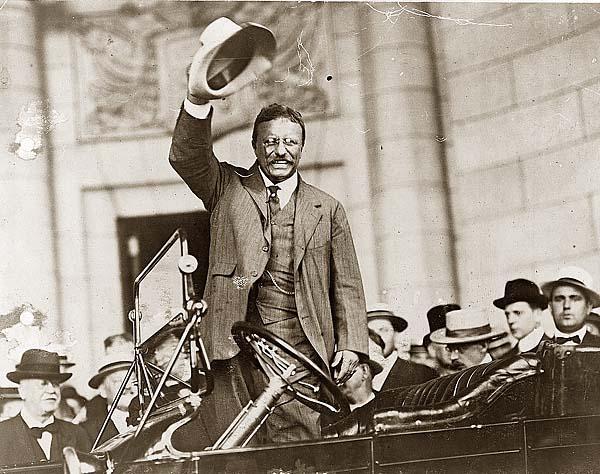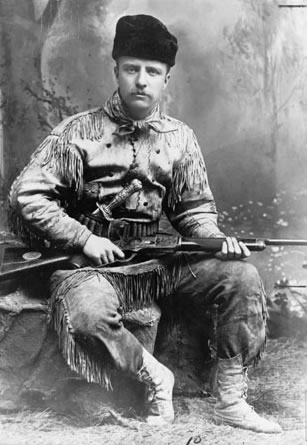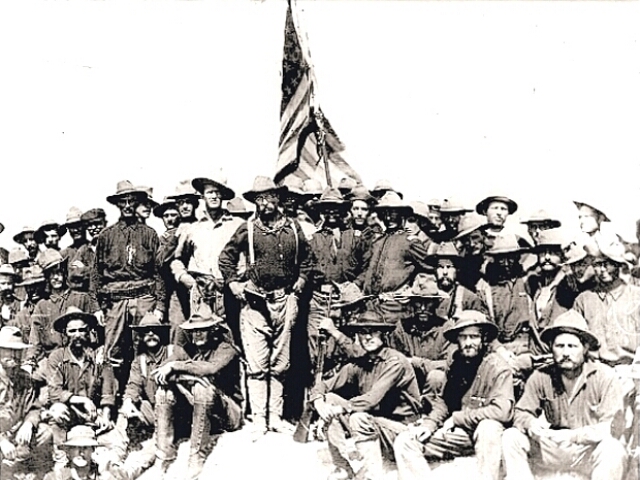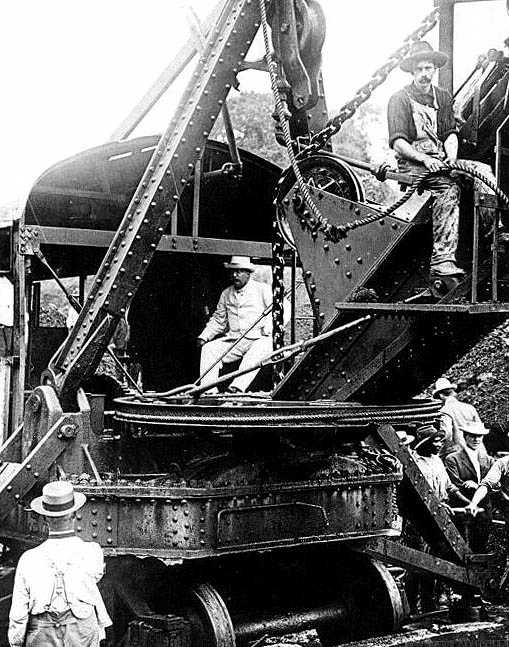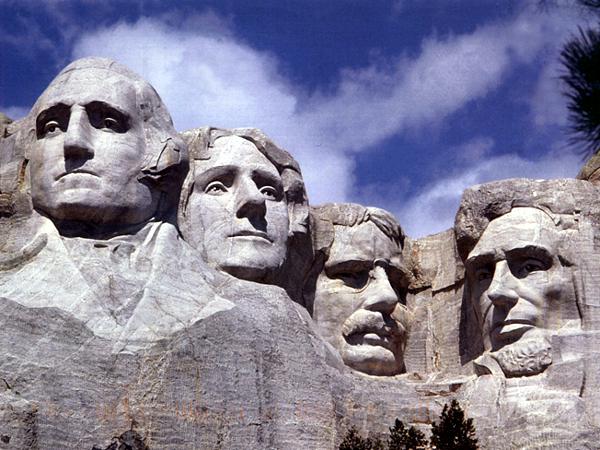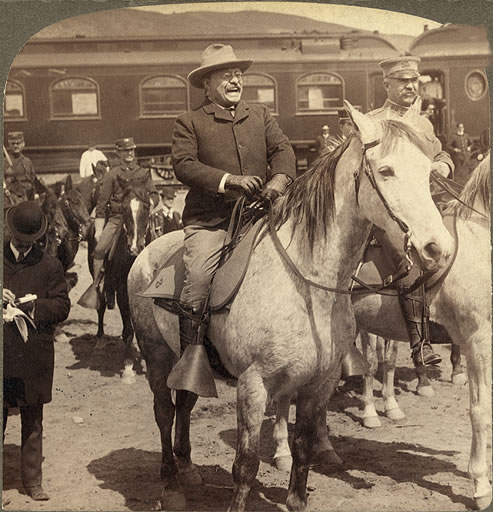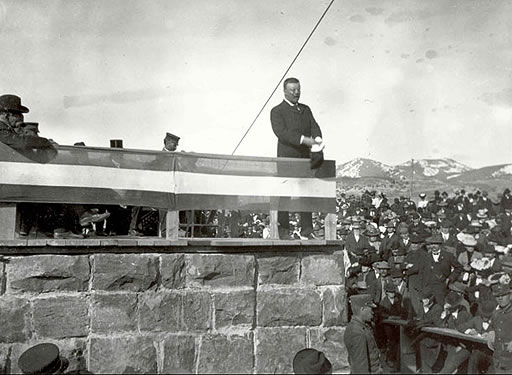
|
||||||||||||
|
|
Theodore "Teddy "Roosevelt
October 27, 1858-January 6, 1919 With the assassination of President McKinley, Theodore Roosevelt, not quite 43, became the youngest President in the Nation's history. He brought new excitement and power to the Presidency, as he vigorously led Congress and the American public toward progressive reforms and a strong foreign policy.
He took the view that the President as a "steward of the people" should take whatever action necessary for the public good unless expressly forbidden by law or the Constitution." I did not usurp power," he wrote, "but I did greatly broaden the use of executive power." Roosevelt's youth differed sharply from that of the log cabin Presidents. He was born in New York City in 1858 into a wealthy family, but he too struggled--against ill health--and in his triumph became an advocate of the strenuous life. In 1884 his first wife, Alice Lee Roosevelt, and his mother died on the same day. Roosevelt spent much of the next two years on his ranch in the Badlands of Dakota Territory. There he mastered his sorrow as he lived in the saddle, driving cattle, hunting big game--he even captured an outlaw.
Theodore Roosevelt, 1885 On a visit to London, he married Edith Carow in December 1886.
During the Spanish-American War, Roosevelt was lieutenant colonel of the Rough Rider Regiment, which he led on a charge at the battle of San Juan. He was one of the most conspicuous heroes of the war. Boss Tom Platt, needing a hero to draw attention away from scandals in New York State, accepted Roosevelt as the Republican candidate for Governor in 1898. Roosevelt won and served with distinction. As President, Roosevelt held the ideal that the Government should be the great arbiter of the conflicting economic forces in the Nation, especially between capital and labor, guaranteeing justice to each and dispensing favors to none. Roosevelt emerged spectacularly as a "trust buster" by forcing the dissolution of a great railroad combination in the Northwest. Other antitrust suits under the Sherman Act followed. Roosevelt steered the United States more actively into world politics. He liked to quote a favorite proverb, "Speak softly and carry a big stick. . . . "
Aware of the strategic need for a shortcut between the Atlantic and Pacific, Roosevelt ensured the construction of the Panama Canal. His corollary to the Monroe Doctrine prevented the establishment of foreign bases in the Caribbean and arrogated the sole right of intervention in Latin America to the United States. He won the Nobel Peace Prize for mediating the Russo-Japanese War, reached a Gentleman's Agreement on immigration with Japan, and sent the Great White Fleet on a goodwill tour of the world. Some of Theodore Roosevelt's most effective achievements were in conservation. He added enormously to the national forests in the West, reserved lands for public use, and fostered great irrigation projects. He crusaded endlessly on matters big and small, exciting audiences with his high-pitched voice, jutting jaw, and pounding fist. "The life of strenuous endeavor" was a must for those around him, as he romped with his five younger children and led ambassadors on hikes through Rock Creek Park in Washington, D.C. Leaving the Presidency in 1909, Roosevelt went on an African safari, then jumped back into politics. In 1912 he ran for President on a Progressive ticket. To reporters he once remarked that he felt as fit as a bull moose, the name of his new party.
While campaigning in Milwaukee, he was shot in the chest by a fanatic. Roosevelt soon recovered, but his words at that time would have been applicable at the time of his death in 1919: "No man has had a happier life than I have led; a happier life in every way."
Mount Rushmore
"Character, in the long run, is the decisive factor in the life of an individual
and of nations alike" -Theodore Roosevelt
Theodore Roosevelt and the
National Park System
Theodore Roosevelt arrives at Yellowstone National Park, 1903 President Theodore Roosevelt's visit to Yellowstone in 1903 was a break from an eight-week national tour during which he delivered over 200 speeches. Yearning to be alone in nature, he immediately set off on horseback with the Army's acting park superintendent, leaving the rest of the presidential entourage behind. At the end of Roosevelt's two-week visit, he spoke at the construction site of a new arch at the north entrance of Yellowstone. In his speech, Roosevelt reminded people of the essential democratic principle embodied by the parks; they were created "for the benefit and enjoyment of the people." These words were later carved into the arch's mantle as a reminder of why the park was there – and for whom.
Theodore Roosevelt delivers speech at cornerstone ceremony for Roosevelt Arch, Yellowstone National Park, 1903 Theodore Roosevelt, the noted conservation president, had an impact on the national park system extending well beyond his term in office. As chief executive from 1901 to 1909, he signed legislation establishing five national parks: Crater Lake, Oregon; Wind Cave, South Dakota; Sullys Hill, North Dakota (later redesignated a game preserve); Mesa Verde, Colorado; and Platt, Oklahoma (now part of Chickasaw National Recreation Area). Another Roosevelt enactment had a broader effect, however: the Antiquities Act of June 8, 1906. While not creating a single park itself, the Antiquities Act enabled Roosevelt and his successors to proclaim ãhistoric landmarks, historic or prehistoric structures, and other objects of historic or scientific interestä in federal ownership as national monuments. Roosevelt did not hesitate to take advantage of this new executive authority. By the end of 1906 he had proclaimed four national monuments: Devils Tower, Wyoming, on September 24 and El Morro, New Mexico, Montezuma Castle, Arizona, and Petrified Forest, Arizona, together on December 8. He was also prepared to interpret the authority expansively, protecting a large portion of the Grand Canyon as a national monument in 1908. By the end of his term he had reserved six predominantly cultural areas and twelve predominantly natural areas in this manner. Half the total were initially administered by the Agriculture Department and were later transferred to Interior Department jurisdiction. Later presidents also used the Antiquities Act to proclaim national monuments,105 in all. Forty-nine of them retain this designation today; others have been retitled national parks or otherwise reclassified by Congress. The Antiquities Act is the original authority for about a quarter of the 378 areas composing the national park system in 1999. Recalling this legacy of Theodore Roosevelt, it seems appropriate that he is now commemorated by five park system areas as many as honor Abraham Lincoln and more than for any other president. Theodore Roosevelt Birthplace National Historic Site in New York City, Sagamore Hill National Historic Site in Oyster Bay, New York, Theodore Roosevelt Inaugural National Historic Site in Buffalo, Theodore Roosevelt National Park in North Dakota, and Theodore Roosevelt Island in Washington, DC, trace his career and memorialize his contributions to America. The National Park Service, administrator of these parklands and the many others Roosevelt made possible, has particular cause to honor his memory. Federal Bird Reservations created by Theodore Roosevelt 1. Pelican Island (Florida) March 14, 1903 . . . .Enlarged January 26, 1909 2. Breton Island (Louisiana) October 4, 1904 3. Stump Lake (N. Dakota) March 9, 1905 4. Siskiwit Islands (Michigan) October 10, 1905 5. Huron Islands (Michigan) October 10, 1905 6. Passage Key (Florida) October 10, 1905 7. Indian Key (Florida) February 10, 1906 8. Tern Islands (Louisiana) August 8, 1907 9. Shell Keys (Louisiana) August 17, 1907 10. Three Arch Rocks (Oregon) October 14, 1907 11. Flattery Rocks (Washington) Oct. 23, 1907 12. Copalis Rock (Washington) October 23, 1907 13. Quillayute Needles (Washington) October 23, 1907 14. East Timbalier Island (Louisiana) December 7, 1907 15. Mosquito Inlet (Florida) February 24, 1908 16. Tortugas Keys (Florida) April 6, 1908 17. Key West (Florida) August 8, 1908 18. Klamath Lake (Oregon and California) August 8, 1908 19. Lake Malheur (Oregon) August 18, 1908 20. Chase Lake (North Dakota) August 28, 1908 21. Pine Island (Florida) Sept. 15, 1908 22. Matlacha Pass (Florida) Sept. 26, 1908 23. Palma Sola (Florida) Sept. 26, 1908 24. Island Bay (Florida) October 23, 1908 25. Loch-Katrine (Wyoming) October 26, 1908 26. Hawaiian Islands February 3, 1909 27. Salt River (Arizona) February 25, 1909 28. East Park (California) February 25, 1909 29. Deer Flat (Idaho) February 25, 1909 30. Willow Creek (Montana) February 25, 1909 31. Carlsbad (New Mexico) February 25, 1909 32. Rio Grande (New Mexico) February 25, 1909 33. Cold Springs (Oregon) February 25, 1909 34. Belle Fourche (South Dakota) Feb. 25, 1909 35. Strawberry Valley (Utah) February 25, 1909 36. Keechelus (Washington) February 25, 1909 37. Kachess (Washington) February 25, 1909 38. Clealum (Washington) February 25, 1909 39. Bumping Lake (Washington) Feb. 25, 1909 40. Conconuily (Washington) February 25, 1909 41. Pathfinder (Wyoming) February 25, 1909 42. Shoshone (Wyoming) February 25, 1909 43. Minidoka (Idaho) February 25, 1909 44. Tuxedni (Alaska) February 27, 1909 45. Saint Lazaria (Alaska) February 27, 1909 46. Yukon Delta (Alaska) February 27, 1909 47. Culebra (Puerto Rico) February 27, 1909 48. Farallon (California) February 27, 1909 49. Behring (Bering) Sea (Alaska) Feb 27, 1909 50. Pribilof (Alaska) February 27, 1909 51. Bogoslof (Alaska) March 2, 1909 National Forests created by Theodore Roosevelt 1. Luquillo (Puerto Rico) January 17, 1903 2. White River (Colorado) May 21, 1904 3. Sevier (Utah) January 17, 1906 4. Wichita (Oklahoma) May 29, 1906 5. Lolo (Montana) November 6, 1906 6. Caribou (Idaho and Wyoming) January 15, 1907 7. Colville (Washington) March 1, 1907 8. Las Animas (Colorado and New Mexico) March 1, 1907 9. Wenaha (Oregon and Washington) March 1, 1907 10. Olympic (Washington) March 2, 1907 11. Manti (Utah) April 25, 1907 12. Manzano (New Mexico) April 16, 1908 13. Kansas (Kansas) May 15, 1908 14. Minnesota (Minnesota) May 23, 1908 15. Pocatello (Idaho and Utah) July 1, 1908 16. Cache (Idaho and Utah) July 1, 1908 17. Whitman (Oregon) July 1, 1908 18. Malheur (Oregon) July 1, 1908 19. Umatilla (Oregon) July 1, 1908 20. Columbia (Washington) July 1, 1908 21. Rainier (Washington) July 1, 1908 22. Washington (Washington) July 1, 1908 23. Chelan (Washington) July 1, 1908 24. Snoqualmie (Washington) July 1, 1908 25. Wenatchee (Washington) July 1, 1908 26. Fillmore (Utah) July I ,1908 27. Nebo (Utah) July 1, 1908 28. Lewis and Clark (Montana) July I ,1908 29. Blackfeet (Montana) July 1, 1908 30. Flathead (Montana) July 1, 1908 31. Kootenai (Montana) July 1, 1908 32. Routt (Colorado) July 1, 1908 33. Cabinet (Montana) July I ,1908 34. Hayden (Colorado and Wyoming) July 1,1908 35. Challis (Idaho) July I ,1908 36. Salmon (Idaho) July 1, 1908 37. Clearwater (Idaho) July 1, 1908 38. Coeur d'Alene (Idaho) July 1, 1908 39. Pend d'Orielle (Idaho) July 1, 1908 40. Kaniksu (Idaho and Washington) July 1, 1908 41. Angeles (California) July 1,1908 42. San Luis (California) July 1, 1908 43. Jemez (New Mexico) July 1, 1908 44. Sundance (Wyoming) July 1, 1908 45. Santa Barbara (California) July I ,1908 46. Weiser (Idaho) July 1, 1908 47. Nez Perce (Idaho) July 1, 1908 48. Idaho (Idaho) July 1, 1908 49. Payette (Idaho) July 1, 1908 50. Boise (Idaho) July 1, 1908 51. Sawtooth (Idaho) July 1, 1908 52. Lemhi (Idaho) July 1, 1908 53. Siuslaw (Oregon) July 1, 1908 54. Cheyenne (Wyoming) July 1, 1908 55. Medicine Bow (Colorado) July 1, 1908 56. Cascade (Oregon) July 1, 1908 57. Oregon (Oregon) July 1,1908 58. Umpqua (Oregon) July 1,1908 59. Siskiyou (Oregon) July 1, 1908 60. Crater (California and Oregon) July 1, 1908 61. Beartooth (Montana) July 1, 1908 62. Holy Cross (Colorado) July 1, 1908 63. Targhee (Idaho and Wyoming) July 1, 1908 64. Teton (Wyoming) July 1, 1908 65. Wyoming (Wyoming) July 1, 1908 66. Bonneville (Wyoming) July I ,1908 67. Absaroka (Montana) July 1, 1908 68. Beaverhead (Montana) July 1,1908 69. Madison (Montana) July 1, 1908 70. Gallatin (Montana) July 1, 1908 71. Deerlodge (Montana) July 1, 1908 72. Helena (Montana) July 1, 1908 73. Missoula (Montana) July 1, 1908 74. Bitterroot (Idaho and Montana) July 1, 1908 75. Ashley (Utah and Wyoming) July 1, 1908 76. Uncompahgre (Colorado) July 1, 1908 77. San Juan (Colorado) July 1, 1908 78. Rio Grande (Colorado) July 1, 1908 79. Pike (Colorado) July 1, 1908 80. Montezuma (Colorado) July 1, 1908 81. Leadville (Colorado) July 1, 1908 82. Gunnison (Colorado) July 1, 1908 83. Cochetopa (Colorado) July 1, 1908 84. Arapaho (Colorado) July 1, 1908 85. Battlement (Colorado) July 1, 1908 86. Shoshone (Wyoming) July 1, 1908 87. Uinta (Utah) July 1, 1908 88. Crook (Arizona) July 1, 1908 89. Coconino (Arizona) July 1, 1908 90. Inyo (California) July 1, 1908 91. Stanislaus (California) July 1, 1908 92. Sierra (California) July 1, 1908 93. Chiricahua (Arizona and New Mexico) July 1, 1908 94. Coronado (Arizona) July 1, 1908 95. Garces (Arizona) July 1, 1908 96. Monterey (California) July 1, 1908 97. San Isabel (Colorado) July 1, 1908 98. Minidoka (Idaho and Utah) July 1, 1908 99. Jefferson (Montana) July 1, 1908 100. Custer (Montana) July 1,1908 101. Nebraska (Nebraska) July 1, 1908 102. Wallowa (Oregon) July 1, 1908 103. Fishlake (Utah) July 1, 1908 104. La Salle (Utah) July 1, 1908 105. Wasatch (Utah) July 1, 1908 106. Powell (Utah) July 1, 1908 107. Bighorn (Wyoming) July 1, 1908 108. Kaibab (Arizona) July 1,1908 109. Deschutes (Oregon) July 14, 1908 110. Fremont (Oregon) July 14, 1908 111. Ocala (Florida) Nov. 24, 1908 112. Dakota (North Dakota) Nov. 24, 1908 113. Choctawhatchee (Florida) Nov. 27, 1908 114. Humboldt (Nevada) January 20, 1909 115. Moapa (Nevada) January 21, 1909 116. Cleveland (California) January 26, 1909 117. Pecos (New Mexico) January 28, 1909 118. Prescott (Arizona) February 1, 1909 119. Calaveras Bigtree (California) February 8, 1909 120. Tonto (Arizona) February 10, 1909 121. Marquette (Michigan) February 10, 1909 122. Nevada (Nevada) February 10, 1909 123. Dixie (Arizona and Utah) February 10, 1909 124. Michigan (Michigan) February 11, 1909 125. Klamath (California and Oregon) February 13, 1909 126. Superior (Minnesota) February 13, 1909 127. Gila (New Mexico) February 15, 1909 128. Black Hills (S. Dakota and Wyoming) February 15, 1909 129.Sioux (Montana and South Dakota) February 15, 1909 130. Tongass (Alaska) February 16, 1909 131. Toiyabe (Nevada) February 20, 1909 132. Datil (New Mexico) February 23, 1909 133. Chugach (Alaska) February 23, 1909 134. Modoc (California) February 25, 1909 135. Ozark (Arkansas) February 25, 1909 136. California (California) February 25, 1909 137. Arkansas (Arkansas) February 27, 1909 138. Mono March 2, 1909 (California and Nevada) 139. Sitgreaves (Arizona) March 2, 1909 140. Lincoln (New Mexico) March 2, 1909 141. Shasta (California) March 2, 1909 142. Alamo (New Mexico) March 2, 1909 143. Carson (New Mexico) March 2, 1909 144. Zuni (Arizona and New Mexico) March 2, 190 9 145. Trinity (California) March 2, 1909 146. Apache (Arizona) March 2, 1909 147. Lassen (California) March 2, 1909 148. Plumas (California) March 2, 1909 149. Tahoe (California) March 2, 1909 150. Sequoia (California) March 2, 1909 National Monuments created by Theodore Roosevelt 1. Devils Tower, Wyoming, September 24, 1906. 2. El Morro, New Mexico, December 8, 1906. 3. Montezuma Castle, Arizona December 8, 1906. 4. Petrified Forest, Arizona, December 8, 1906. 5. Chaco Canyon, New Mexico, March 11, 1907. 6. Lassen Peak, California, May 6, 1907. 7. Cinder Cone, California, May 6, 1907. 8. Gila Cliff Dwellings, New Mexico November 16, 1907. 9. Tonto, Arizona, December 19, 1907. 10. Muir Woods, California, January 9, 1908. 1 1. Grand Canyon, Arizona, January 11, 1908 12. Pinnacles, California, January 16, 1908. 13. Jewel Cave, South Dakota, February 7, 1908. 14. Natural Bridges, Utah, April 16, 1908. 15. Lewis & Clark, Montana, May 11, 1908 . . . . (later given to the State of Montana). 16. Tumacacori, Arizona, September 15, 1908. 17. Wheeler, Colorado, December 7, 1908 . . . . (given to the Forest Service in 1950). 18. Mount Olympus, Washington, March 2, 1909. Quotations from the
speeches and other works of "We demand that big
business give the people a square deal; in return we must insist that when
anyone engaged in big business honestly endeavors to do right he shall himself
be given a square deal." "It is not the critic
who counts: not the man who points out how the strong man stumbles or
where the doer of deeds could have done better. The credit belongs to the man
who is actually in the arena, whose face is marred by dust and sweat and blood,
who strives valiantly, who errs and comes up short again and again, because
there is no effort without error or shortcoming, but who knows the great
enthusiasms, the great devotions, who spends himself for a worthy cause; who, at
the best, knows, in the end, the triumph of high achievement, and who, at the
worst, if he fails, at least he fails while daring greatly, so that his place
shall never be with those cold and timid souls who knew neither victory nor
defeat." "...the man who really counts in the world is the doer, not the mere critic-the man who actually does the work, even if roughly and imperfectly, not the man who only talks or writes about how it ought to be done." "The President is merely the most important among a large number of public servants. He should be supported or opposed exactly to the degree which is warranted by his good conduct or bad conduct, his efficiency or inefficiency in rendering loyal, able, and disinterested service to the Nation as a whole. Therefore it is absolutely necessary that there should be full liberty to tell the truth about his acts, and this means that it is exactly necessary to blame him when he does wrong as to praise him when he does right. Any other attitude in an American citizen is both base and servile. To announce that there must be no criticism of the President, or that we are to stand by the President, right or wrong, is not only unpatriotic and servile, but is morally treasonable to the American public. Nothing but the truth should be spoken about him or any one else. But it is even more important to tell the truth, pleasant or unpleasant, about him than about any one else." "Optimism is a good characteristic, but if carried to an excess, it becomes foolishness. We are prone to speak of the resources of this country as inexhaustible; this is not so." "A
healthy-minded boy should feel hearty contempt for the coward and even more
hearty indignation for the boy who bullies girls or small boys, or tortures
animals."..."What we have a right to expect of the American boy is that he shall
turn out to be a good American man."
Credit: The Whitehouse, The National Park Service, Theodore Roosevelt Association |
